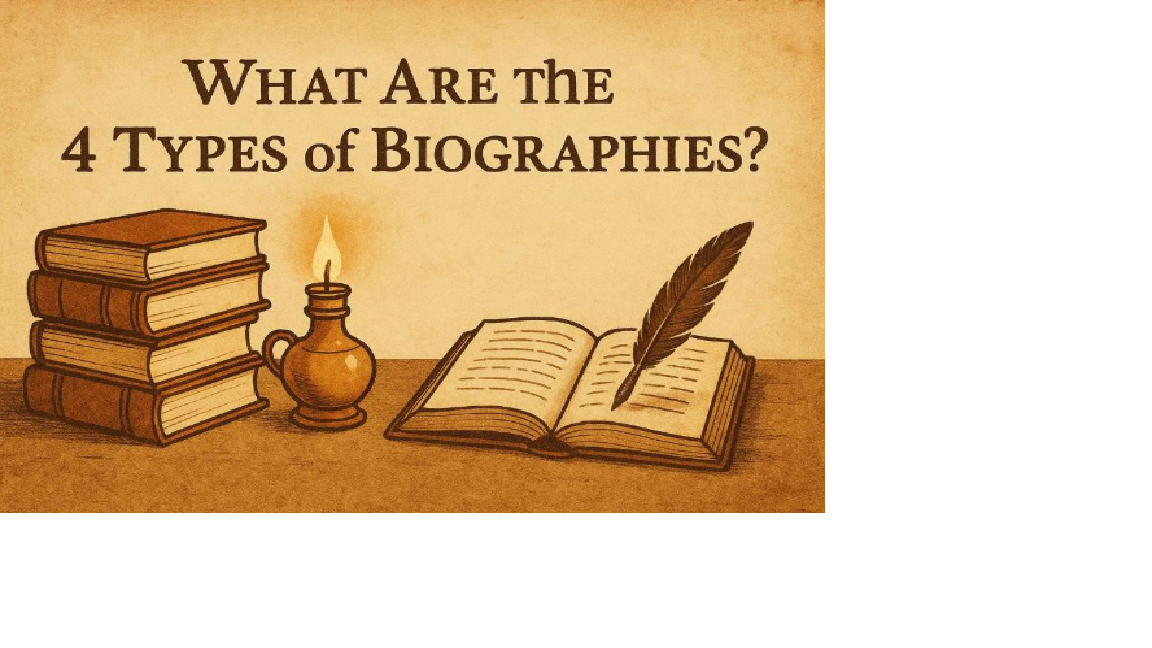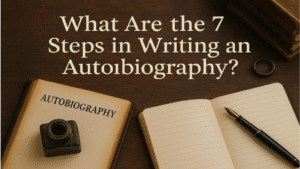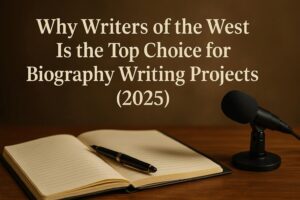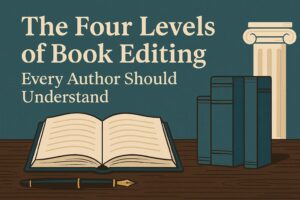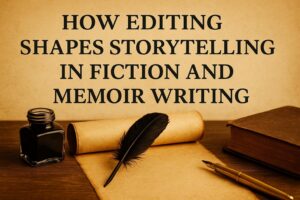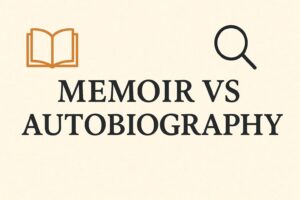Learn the 4 main types of biographies; historical fiction, academic, fictional academic, and prophetic. This clear 2025 guide explains each type with definitions, examples, pros and cons, and tips for choosing the right one for school, reading, or writing your own biography.
Introduction
Here is the simple truth. Not every biography is built the same way. Some focus on verified facts. Some aim to read like a story. Others are written from a faith perspective. When you pick up different books expecting them to follow the same rules, it is easy to feel confused about what you are actually reading.
That is why understanding the main types of biographies matters. It helps you know what you can trust as factual, what is partly imagined, and what is shaped by a specific viewpoint. It also helps you choose the right kind of book for your assignment, your reading goals, or the biography you want to write yourself.
My role here is to make the whole thing clear and easy. In this guide, you will get straightforward definitions of the four main types of biographies, examples you can recognize, and a simple way to decide which type fits your purpose.
Overview: The 4 Main Types of Biographies
Before you dive into the details, it helps to see the full landscape at once. Biographies are written with different goals, different levels of research, and different expectations of accuracy. The four types below give you a clear framework that makes sense for students, general readers, and new writers who want a simple starting point without getting lost in academic jargon.
Historical Fiction Biography
This type is rooted in a real person’s life but shaped with creative techniques. Authors add imagined scenes, reconstructed conversations, and dramatic moments that help bring the story to life. The core facts are still there, but the storytelling is more flexible and emotional. Readers often choose this type when they want history to feel vivid, personal, and cinematic.
Academic Biography
This type is the most research heavy. It uses documents, letters, interviews, and archival records to build a careful account of a person’s life. Writers separate proven facts from reasonable interpretation and from areas where information is missing. Academic biographies are clear, detailed, and reliable, which makes them ideal for school work or serious study.
Fictional Academic Biography
This type sits between the first two. The research is real, but the author fills in gaps with imaginative but thoughtful reconstruction. Instead of inventing wild storylines, the writer uses creative techniques to make the documented life feel more intimate and readable. It works well when sources are limited or when the writer wants to keep both accuracy and emotional depth.
Prophetic Biography
This type focuses on religious or spiritual figures. The writer approaches the subject through faith, meaning, purpose, and the moral lessons their life represents. It is common in spiritual traditions and is often used for teaching or inspiration.
If you’re someone who doesn’t feel like their writing style fit your required type of biography, biography writers for hire are always a safe option to get a complete biography, written professionally, and with very little effort on your part.
Type 1: Historical Fiction Biography
What It Is
A historical fiction biography is a narrative built on a real person’s life but told with creative freedom. The factual outline of the person’s timeline guides the story, yet the author fills the empty spaces with imagined scenes, conversations, and emotional moments that history never recorded. Instead of sticking only to verifiable records, writers shape the narrative to feel like a novel. The goal is to make the life feel immediate and human, especially when the historical record is thin or distant.
This type is popular because it blends accuracy with storytelling. Readers get the broad truth of who the person was, but they also get the color and atmosphere that strict nonfiction cannot always provide.
Key Features
A historical fiction biography is always story first. It uses scene building, sensory detail, and close narration to create momentum. Writers might adjust timelines for clarity, combine several real people into one character, or imagine emotional responses the subject might have had. These choices make the story smoother and more engaging, but they also mean the book should not be treated as a strict factual source. It is a creative interpretation of a real life.
Common Uses and Examples
You will see this type in historical novels based on real figures, in books adapted into films, and in stories written to make complex eras easier to picture. Readers choose it when they want history to feel alive rather than academic. It works well for younger readers, general audiences, and anyone who wants an accessible starting point before exploring more documented sources.
Pros and Cons
Pros
• Very engaging and easy to read
• Helps readers visualize historical settings and emotions
• Great entry point before deeper research
Cons
• Some details are invented
• Not dependable as a sole factual reference
• Can blur the line between truth and interpretation if readers are not careful
When people talk about the types of biographies, this one is often the most misunderstood. It is valuable, but only when you know what part is fact and what part is crafted for storytelling.
Type 2: Academic Biography
What It Is
An academic biography is the most carefully documented kind of life story. It is usually written by historians, scholars, or experts in a specific field who care deeply about evidence. The writer studies letters, diaries, official records, newspaper archives, and earlier research, then shapes that material into a clear account of one person’s life.
The goal is not just to tell what happened. The goal is to show how and why it happened, and how that life fits into a larger historical context. Academic biographies answer questions like, What forces shaped this person, what choices did they actually make, and what impact did they really have?
Key Features
You can usually spot an academic biography by its structure and detail. It often follows a chronological order. Early life, turning points, main work or mission, then legacy. There will be notes, citations, and a bibliography that show where information came from.
A good academic biographer separates three things very clearly. Proven facts that come straight from documents. Reasonable interpretations that fit the evidence. Unknown or disputed areas, where the writer admits what cannot be confirmed. That honesty is part of what gives this type its power.
Where You Will See It
You will find academic biographies in university presses, scholarly series, and serious nonfiction sections of libraries or bookstores. Many prize winning biographies are academic in method, even if they are written in a more accessible style.
Teachers often recommend this type for school projects, since it gives students a strong factual base. Even the best memoir writing companies still rely on this kind of research mindset when they help people tell real life stories.
Pros and Cons
Pros
• High level of accuracy and depth
• Clear sourcing through notes and references
• Very useful for essays, reports, and serious research
Cons
• Can feel dense or slow for casual readers
• Less room for imaginative scenes or invented dialogue
• Emotional moments may be described more cautiously
If you need reliability first, this is the strongest type to start with. Once you understand the academic version of a life, you can explore more creative forms without losing your grip on the facts.
Type 3: Fictional Academic Biography
What It Is
A fictional academic biography is a hybrid form that blends solid research with thoughtful imagination. The foundation of the story comes from real documents, letters, interviews, and verified historical records. When the evidence runs out, the writer fills the gaps with carefully considered scenes or inner thoughts that could reasonably fit the person’s life. This approach gives readers the depth of research found in academic work and the emotional closeness found in narrative storytelling.
Writers use this type when they want accuracy but also want the life to feel personal and textured. It works especially well when the subject lived in a period where sources are incomplete or scattered.
Key Features
A fictional academic biography is transparent about its methods. Writers often explain where the evidence is solid and where they are stepping into reconstruction. This honesty helps readers understand what is factual and what is interpretive. The narrative is more flexible than a strict academic biography, but it never ignores the historical record.
You might see interior monologue, symbolic detail, or imagined transitions between documented events. The goal is not to invent a new life. The goal is to make a documented life readable, relatable, and full of momentum.
When It Is Used
This type is especially useful when the subject left behind partial archives, lost letters, or conflicting accounts. Writers who want to respect the facts but also keep the reader emotionally engaged choose this form. It is also helpful for teachers and students who want a richer understanding of a historical figure without losing sight of accuracy.
Readers who enjoy narrative nonfiction often appreciate this type because it offers both intellect and emotion. It sits in the middle of the spectrum of types of biographies, which makes it flexible for many purposes.
Pros and Cons
Pros
• Strong balance of fact and storytelling
• Helps readers feel connected to the subject
• Useful when documentation is incomplete
Cons
• Requires trust in the author’s judgment
• Not always accepted as fully scholarly
• Can blur boundaries for readers who prefer strict nonfiction
Type 4: Prophetic Biography
What It Is
A prophetic biography focuses on the life of a religious or spiritual figure and is written from a faith based perspective. The writer is not only recording events. The writer is interpreting those events through belief, devotion, and the spiritual meaning they carry for the community. This approach highlights purpose, divine guidance, miracles, signs, and the moral lessons that the person’s life represents.
Unlike academic biographies that focus on documentation, prophetic biographies focus on significance. The question is not only what happened. The question is what the events mean for believers and how the subject’s life expresses spiritual truth.
Key Features
A prophetic biography typically uses a guiding, respectful tone. It describes the subject’s virtues, character, and growth with the intention of teaching or inspiring readers. The narrative is not neutral. It is shaped by the beliefs of the writer or the community the biography is written for.
Miracles or extraordinary events are presented as part of the person’s mission. Moral lessons may be explained directly. The goal is to support faith and understanding rather than to question or debate the events.
When It Is Used
This type appears often in religious traditions where the life of a founder, teacher, or spiritual leader is a core part of cultural identity. These biographies are used for devotion, study, or guidance. They are common in religious schools, temples, churches, and community learning settings.
People also turn to prophetic biographies when they want inspiration, not just information. They can help readers understand the values and teachings embodied in the subject’s life. When writers or editors approach this material, they often use the same respect and care that professional biography editing services apply to historical or literary subjects.
Pros and Cons
Pros
• Inspirational and meaningful for readers
• Provides clear moral or spiritual lessons
• Strong connection to cultural and religious identity
Cons
• Not neutral or analytical
• May blend history with faith based interpretation
• Not suited for assignments that require strictly documented facts
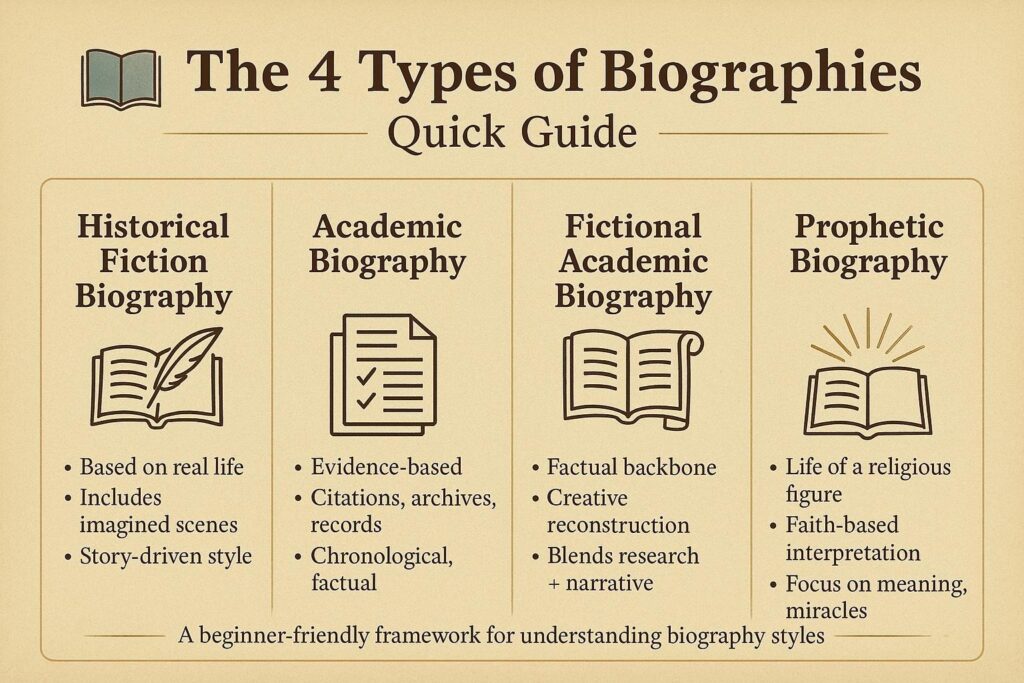
Other Ways Experts Classify Biographies Beyond the Big Four
Why More Than Four Types Exist
When you look up information about biography categories, you might be surprised by how inconsistent the answers are. Some sources say there are four types. Others say five. Some list ten or more. This variation is not a mistake. It happens because different fields study biography in different ways. Historians, literary scholars, social scientists, teachers, and online platforms each classify biographies according to their own goals. Understanding this helps you avoid confusion and explains why no single list appears everywhere.
The four main types discussed earlier serve as a simple, clear framework for beginners. The categories below show how professionals expand on that framework for deeper study or practical use.
Scholarly Chronicles
A scholarly chronicle is one of the oldest and most traditional biography formats. It follows a strict chronological timeline and focuses on documented events. The writer does not try to dramatize the story or explore emotional possibilities. Instead, the emphasis stays on recorded facts, primary documents, and verifiable sources.
This type is similar to an academic biography but with even more attention to sequence and historical precision. You will see this category used in historical research, archival studies, and academic journals where accuracy outweighs storytelling.
Intellectual Biographies
An intellectual biography focuses on a person’s ideas rather than their personal experiences. If the subject is a philosopher, scientist, political thinker, or influential writer, this type traces how their thinking developed and how their work shaped their field.
Personal details appear only when they help explain the subject’s intellectual evolution. These biographies are common in universities because they give students a clear understanding of how a person’s body of work changed over time and why it mattered.
Life History and Narrative Approaches
Another classification used in social sciences is the life history. This type relies heavily on interviews, oral accounts, and direct storytelling from the subject or their community. It is often used when the person did not leave behind written archives or formal records.
Life histories are valuable for understanding people whose experiences reflect broader cultural or social themes. Sociologists, anthropologists, and community historians use this form to document voices that traditional academic writing sometimes overlooks.
Narrative biographies fall into this area too. These books use storytelling techniques but remain grounded in research. The goal is to communicate a person’s life clearly while keeping the structure and language engaging.
Modern Practical Categories
In today’s digital world, you will also find more practical or marketing based categories. These include teacher biographies, actor biographies, athlete biographies, and professional biographies. These are not literary genres. They exist because websites and directories use them to help readers quickly sort information.
You will also see these categories used by companies that help people write their life stories. For example, people searching for biography writers for hire often sort by industry or purpose rather than by literary tradition. These categories are helpful online but are not part of scholarly classification.
Why These Lists Differ
The reason you see so many lists is that biography is a flexible form. Scholars use precise categories to study how ideas, documents, and cultural forces shape a life. Teachers use simple lists to help students understand the basics. Online platforms use practical labels to organise profiles and services.
The four types presented earlier give beginners a clear starting point. The additional classifications above show how rich and complex biography can be once you look deeper.
Where This Leads Next
Now that you understand why biography categories vary so widely, you are better prepared to choose the right type for your project, your reading goals, or your writing plans. Ready for the next section?

How to Choose the Right Type of Biography for Your Purpose
Choosing When You Are a Student
If you are working on a school project, the most important factor is accuracy. Teachers want to see sources, evidence, and clear documentation. Because of that, academic biographies and scholarly chronicles are your strongest choices. These books give you verified information, citations you can reference, and a clear timeline you can trust.
When you choose a book, look at the back pages or the end of each chapter. If you see notes, references, or a sources section, that is a good sign. It means the writer used real documents and verifiable information. Historical fiction biographies can be helpful for understanding mood or context, but they should not be your only source for assignments that require factual accuracy.
If your teacher allows more creative options, a fictional academic biography can give you both solid research and richer storytelling. It keeps you grounded in truth while offering a more engaging reading experience.
Choosing When You Are a General Reader
If you read for enjoyment, you have much more freedom. Many general readers want a book that feels alive, emotional, or dramatic. If that is you, a historical fiction biography or a fictional academic biography will likely be your best starting point.
These types feel more like stories than textbooks. They give you atmosphere, personality, and a sense of closeness to the subject. You still learn about the person, but you also enjoy the experience. Narrative biographies can be great choices here as well because they offer factual grounding with an accessible tone.
If you prefer nonfiction that feels literary without being slow or overly technical, look for writers known for strong narrative style. You will find these qualities in many award winning biographies and in books recommended by some of the best memoir writing companies, since they understand how to balance truth with engaging storytelling.
Choosing When You Are a Writer Planning a Book
If you are planning to write a biography, start by asking yourself one important question. Are you trying to document or dramatize? Your answer determines the type that fits your project.
If your goal is to create a reference worthy, research heavy biography, then the academic model is your best fit. It requires strong sourcing, careful note keeping, and a structured approach.
If your goal is to create an inspiring or emotionally powerful story, you might choose a fictional academic biography or a historical fiction biography. These allow you to reconstruct scenes and fill in gaps while still respecting the truth.
If your subject is a spiritual figure or a person whose life is deeply tied to faith, a prophetic biography may be the most appropriate approach. It centers meaning and spiritual purpose rather than neutral analysis.
Students need accuracy. Casual readers want engagement. Writers need clarity about their purpose. Once you understand your goal, choosing the right type of biography becomes simple and practical.
Common Mistakes When Talking About Biography Types
Mistake 1: Treating Autobiography and Memoir as Types of Biography
One of the most common misunderstandings is grouping autobiography, memoir, and biography into the same category. They all tell life stories, but they are not the same form. A biography is written by someone other than the subject. An autobiography is the subject telling their own life story. A memoir focuses on a specific theme, period, or experience rather than the complete timeline. When these genres get mixed together, students often choose the wrong book for an assignment, or writers approach their project with the wrong expectations. Keeping the distinctions clear will save you time and frustration.
Mistake 2: Assuming There Is One Official List of Types
Many people believe there is one definitive list of biography types, but there is no universal standard. Teachers, scholars, and online resources use different classifications depending on their goals. Some lists focus on literary style, others on academic purpose, and others on practical categories. The four type model used in this guide is a simplified framework designed for beginners. Once you understand that different lists serve different functions, the variety becomes much easier to navigate.
Mistake 3: Using Historical Fiction as a Main Factual Source
Historical fiction biographies can be incredibly engaging, but they often include imagined scenes, reconstructed dialogue, and adjusted timelines. They are valuable for understanding the emotional truth of a life, but they should not be treated as reliable factual sources on their own. Students and new readers sometimes assume that because the story is based on a real person, everything in it must be true. Instead, treat historical fiction as a supplement. Pair it with academic or narrative nonfiction if you need accuracy.
Mistake 4: Ignoring Sources and Citations
Another major mistake is not checking how well a biography is sourced. A book that appears detailed may still contain speculation if the author does not clearly cite where information came from. Looking for notes, references, and a bibliography is one of the easiest ways to judge reliability. When a biography avoids sources altogether, it becomes much harder to separate fact from interpretation. This matters especially for school projects and research writing.
Mistake 5: Assuming All Biographies Aim for Neutrality
Some biographies are written with a clear perspective. Prophetic biographies use a faith based lens. Narrative biographies emphasize storytelling. Fictional academic biographies mix research with imagination. Each type has a purpose, and none are wrong. The problem appears when readers assume all biographies aim for the same standard of neutrality. Understanding the intention behind the book helps you interpret the material accurately.
Avoiding these mistakes makes it easier to choose the right book, understand what you are reading, and write more effectively.
FAQs
Q1. What are the 4 main types of biographies?
The four types most commonly used in beginner and educational settings are historical fiction biography, academic biography, fictional academic biography, and prophetic biography. These four categories help simplify a wide range of approaches so students and new readers can understand the main differences without getting overwhelmed.
Q2. Which type of biography is the most factual?
Academic biographies are usually the most accurate because they rely on documented sources such as letters, journals, interviews, archives, and formal records. Scholarly chronicles also fit into this category since they focus on chronology and verifiable evidence. These types avoid speculation and keep interpretation separate from fact, which makes them ideal for school assignments or research.
Q3. Are autobiographies and memoirs types of biography?
No. An autobiography is written by the person themselves, and a memoir focuses on a particular theme or period instead of a full life story. Both are forms of life writing, but they are not considered types of biography because biographies are written by someone other than the subject.
Q4. Can a biography be partly fictional?
Yes. Some biographies include imaginative elements, especially when documentation is limited. Historical fiction biographies often use invented scenes and dialogue for dramatic effect. Fictional academic biographies allow writers to fill in gaps with reasonable interpretation while still grounding the story in research. As long as the writer is honest about where imagination begins, this approach is acceptable.
Q5. Why do some sources list five or even ten types of biography instead of four?
Different fields categorize biographies according to their own needs. Scholars may use terms like intellectual biography or life history. Online platforms might separate biographies by profession. Teachers often choose simplified lists for clarity. There is no single official system, which is why you will see multiple versions across different websites and textbooks.
Q6. Which type of biography should I read if I am just starting out?
If you are reading for school, choose an academic biography or a well reviewed narrative biography with strong sourcing. If you want something entertaining or emotionally rich, try a historical fiction biography or a fictional academic biography. If your goal is spiritual inspiration, a prophetic biography from a trusted tradition is a strong fit.
Conclusion
Choosing the right type of biography becomes much easier once you understand the purpose behind each form. Historical fiction biographies make real lives feel vivid and dramatic. Academic biographies give you accuracy and depth. Fictional academic biographies bridge the gap between fact and storytelling. Prophetic biographies offer meaning and spiritual interpretation. Each type serves a different reader and a different goal, and none of them are “better” in a universal sense. They simply answer different needs.
When you recognize these differences, you can approach any biography with clarity. Students can select reliable sources for assignments. General readers can pick books that feel engaging instead of overwhelming. Writers can choose a structure that matches their vision. Even the best memoir writing companies rely on these distinctions when helping people shape their stories, because the form you choose determines the experience you create.
The more you read and compare these approaches, the more confident you become in understanding how a life story is built. With this guide, you now have a clear framework that helps you navigate the many ways a person’s life can be told.

